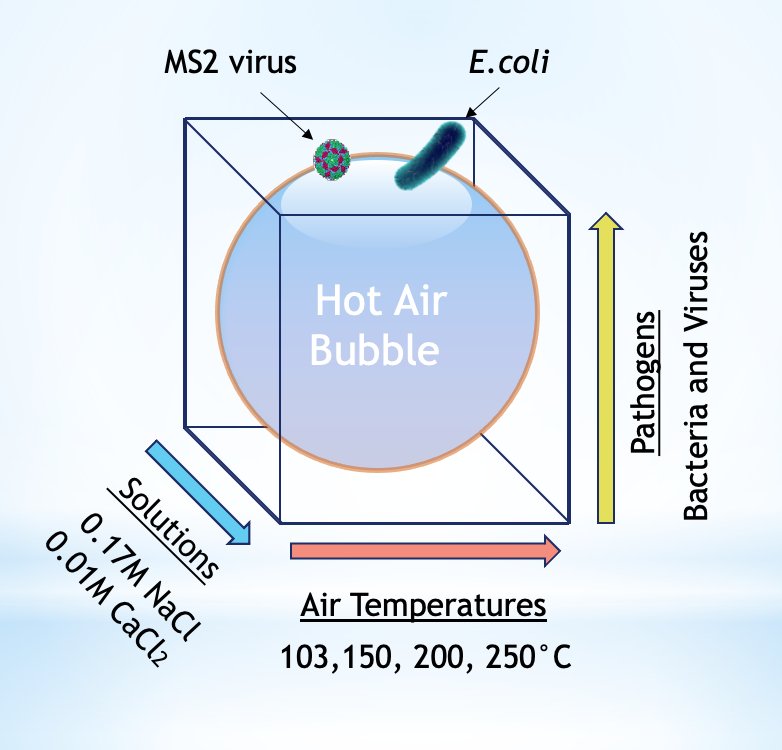Thermal Inactivation of Viruses and Bacteria with Hot Air Bubbles in Different Electrolyte Solutions

Published 2021-03-22
Keywords
- Virus,
- E. Coli,
- inactivation,
- coalescence inhibition,
- hot bubble column evaporator (HBCE)
- sterilisation ...More
How to Cite
Copyright (c) 2020 Adrian Garrido Sanchis

This work is licensed under a Creative Commons Attribution 4.0 International License.
Abstract
Inactivation of viruses has been an insuperable inhibition to the use of recycled water. Substantial success in solving the problem has recently been achieved using a hot column evaporator (HBCE). Here we extend the technique to inactivate E.coli and MS2 viruses in different electrolyte solutions (0.17M NaCl and 0.01M CaCl2). An increase in the inlet air temperature, from 103°C to 250°C, substantially improved the destruction of both pathogenic groups in either solution. E.coli proved to be more susceptible than viruses to inactivation in the HBCE.
The phenomenon of inhibition of bubble coalescence above 0.17M for the NaCl solutions makes the HBCE process for this solution more efficient than for CaCl2 solutions. In part, this is because of the higher air/water interfacial area with NaCl.
References
- A. Garrido Sanchis, R. Pashley, B. Ninham, Virus and bacteria inactivation by CO2 bubbles in solution, npj Clean Water, 2019, 2(1), 5.
- N. Kantarci, F. Borak, K.O. Ulgen, Bubble column reactors, Process Biochem, 2005, 40(7), 2263-2283.
- W.D. Deckwer, On the mechanism of heat transfer in bubble column reactors, Chem Eng Sci, 1980, 35(6), 1341-1346.
- M. Shahid, R.M. Pashley, R.A.F.M. Mohklesur, Use of a high density, low temperature, bubble column for thermally efficient water sterilization, Desalin Water Treat, 2013, 52(22-24), 4444-4452.
- A. Garrido, R.M. Pashley, B.W. Ninham, Low temperature MS2 (ATCC15597-B1) virus inactivation using a hot bubble column evaporator (HBCE), Colloids Surf B, 2016, 151, 1-10.
- V.S.J. Craig, B.W. Ninham, R.M. Pashley, Effect of electrolytes on bubble coalescence, Nature, 1993, 364(6435), 317-319.
- M. Brennecke, Virus_aggregation final, in Laboratorie de Chimie Environnementale (LCE). 2009, Ecole Polytechnique Federale de Lausanne. p. 47.
- J. Cormier, M. Janes, A double layer plaque assay using spread plate technique for enumeration of bacteriophage MS2, J Virol Methods, 2014, 196, 86-92.
- M.R.J. Clokie, A.M. Kropinski, Enumeration of Bacteriophages by Double Agar Overlay Plaque Assay, in Bacteriophages, U.o. Leicester, Editor. 2009: Humana Press.
- ATCC, Mehtod 1602: Male-specific (F+) and Somatic Coliphage in Water by Single Agar Layer (SAL), U.S.E.P.A.O.o. Water., Editor. 2001. p. 30.
- ATCC, Product Information Sheet for ATCC 15597-B1, A.T.C.C. (ATCC), Editor. 2005, ATCC. p. 2.
- G. Reshes, S. Vanounou, I. Fishov, M. Feingold, Cell shape dynamics in Escherichia coli, Biophys J, 2008, 94(1), 251-264.
- X. Yang, Introduction, in A Study on Antimicrobial Effects of Nanosilver for Drinking Water Disinfection. 2017, Springer Singapore: Singapore. p. 1-12.
- I. Gaska, O. Bilenko, S. Smetona, Y. Bilenko, R. Gaska, M. Shur, Deep UV LEDs for Public Health Applications, Int J High Speed Electron, 2014, 23(03n04), 1450018.
- ATCC, Product Sheet Escherichia coli (ATCC 15597), ATCC, Editor. 2015.
- I. 10705-1, Water quality - Detection and enumeration of bacteriphages- Part 1, in ISO 10705-1. 1995, International Organization for Standardization: ISO.
- U.S.E.P. Agency, Preparing and Assaying Challenge Microorganismos. 2006. p. 267- 277.
- K. Valegard, L. Liljas, K. Fridborg, T. Unge, The three-dimensional structure of the bacterial virus MS2, Nature, 1990, 345(6270), 36-41.
- M.R.J. Clokie, A.M. Kropinski, Enumeration of Bacteriophages by Double Agar Overlay Plaque Assay, in Bacteriophages, U.o. Leicester, Editor. 2009: Humana Press.
- M.I. Ltd., Zetasizer Nano User Manual, M.I. Ltd., Editor. 2009. p. 312.
- K. Seo, Lee, J. E., Lim, M. Y., Ko, G., Effect of temperature, pH, and NaCl on the inactivation kinetics of murine norovirus, J Food Prot, 2012, 75(3), 533-40.
- J. Smelt, S. Brul, Thermal Inactivation of Microorganisms. Vol. 54. 2014. 1371-85.
- A. Garrido, R.M. Pashley, B.W. Ninham, Water sterilisation using different hot gases in a bubble column reactor, J Environ Chem Eng, 2018, 6(2), 2651-2659.
- X. Xue, R.M. Pashley, A study of low temperature inactivation of fecal coliforms in electrolyte solutions using hot air bubbles, Desalin Water Tret, 2015, 1-11.
- M. Shahid, C. Fan, R.M. Pashley, Insight into the bubble column evaporator and its applications, Int Rev Phys Chem, 2016, 35(1), 143-185.
- C. Fan, M. Shahid, R.M. Pashley, Studies on Bubble Column Evaporation in Various Salt Solutions, J Solution Chem, 2014, 43(8), 1297-1312.
- C. WHO - Geneva, World Health Organization, Guidelines for drinking-water quality, W.H. Organization, Editor. 2007. p. 38.
- A.G. Sanchis, M. Shahid, R.M. Pashley, Improved virus inactivation using a hot bubble column evaporator (HBCE), Colloids Surf B, 2018, 165, 293-302.




